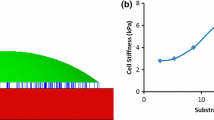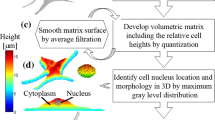Abstract
Cells within connective tissues are routinely subjected to a wide range of non-uniform mechanical loads that regulate many cell behaviors. In the present study, the relationship between cell orientation angle and strain value of the membrane was comprehensively investigated using an inhomogeneous strain field. Additionally, the cellular axial strain threshold, which corresponds to the launching of cell reorientation response, was elucidated. Human bone marrow mesenchymal stem cells were used for these experiments. In this study, an inhomogeneous strain distribution was easily created by removing one side holes of an elastic chamber in a commonly used uniaxial stretching device. The strains of 2D stretched membranes were quantified on a position-by-position basis using the digital image correlation method. The normal strain in the direction of stretch was changed continuously from 2.0 to 15.0 %. A 3D histogram of the cell frequency, which was correlated with the cell orientation angle and normal strain of the membrane, made it possible to determine the axial strain threshold accurately. The value of the axial strain threshold was 4.4 ± 0.3 %, which was reasonable compared with previous studies based on cyclic uniaxial stretch stimulation (homogeneous strain field). Additionally, preferential axial strain of cells, which was a cell property firstly introduced, was also achieved and the value was −2.0 ± 0.1 %. This study is novel in three respects: (i) it precisely and easily determined the axial strain threshold of cells; (ii) it is the first to suggest preferential axial strain of cells; and (iii) it methodically investigated cell behavior in an inhomogeneous strain field.











Similar content being viewed by others
References
Ingber, D. E. (1997). Tensegrity: The architectural basis of cellular mechanotransduction. Annual Review of Physiology, 59, 575–599.
Giannone, G., & Sheetz, M. P. (2006). Substrate rigidity and force define form through tyrosine phosphatase and kinase pathways. Trends in Cell Biology, 16(4), 213–223.
Tipton, C. M., Matthes, R. D., Maynard, J. A., & Carey, R. A. (1975). Influence of physical-activity on ligaments and tendons. Medicine & Science in Sports & Exercise, 7(3), 165–175.
Woo, S. L. Y., Gomez, M. A., Woo, Y. K., & Akeson, W. H. (1982). Mechanical-properties of tendons and ligaments. II. The relationships of immobilization and exercise on tissue remodeling. Biorheology, 19(3), 397–408.
Wang, H. C., Ip, W., Boissy, R., & Grood, E. S. (1995). Cell orientation response to cyclically deformed substrates: Experimental validation of a cell model. Journal of Biomechanics, 28(12), 1543–1552.
Neidlinger-Wilke, C., Grood, E. S., Wang, J. H. C., Brand, R. A., & Claes, L. (2001). Cell alignment is induced by cyclic changes in cell length: Studies of cells grown in cyclically stretched substrates. Journal of Orthopaedic Research, 19(2), 286–293.
Zhang, L., Kahn, C. J. F., Chen, H. Q., Tran, N., & Wang, X. (2008). Effect of uniaxial stretching on rat bone mesenchymal stem cell: Orientation and expressions of collagen types I and III and tenascin-C. Cell Biology International, 32(3), 344–352.
Morita, Y., Watanabe, S., & Ju, Y. Determination of optimal cyclic uniaxial stretches for stem cell-to-tenocyte differentiation under a wide range of mechanical stretch conditions by evaluating gene expression and protein synthesis levels. Acta of Bioengineering and Biomechanics (accepted).
Arold, S. P., Wong, J. Y., & Suki, B. (2007). Design of a new stretching apparatus and the effects of cyclic strain and substratum on mouse lung epithelial-12 cells. Annals of Biomedical Engineering, 35(7), 1156–1164.
Raeber, G. P., Lutolf, M. P., & Hubbell, J. A. (2008). Part II: Fibroblasts preferentially migrate in the direction of principal strain. Biomechanics and Modeling in Mechanobiology, 7(3), 215–225.
Breen, E. C., Fu, Z. X., & Normand, H. (1999). Calcyclin gene expression is increased by mechanical strain in fibroblasts and lung. The American Journal of Respiratory Cell and Molecular Biology, 21(6), 746–752.
Yang, G. G., Crawford, R. C., & Wang, J. H. C. (2004). Proliferation and collagen production of human patellar tendon fibroblasts in response to cyclic uniaxial stretching in serum-free conditions. Journal of Biomechanics, 37(10), 1543–1550.
Koike, M., Shimokawa, H., Kanno, Z., Ohya, K., & Soma, K. (2005). Effects of mechanical strain on proliferation and differentiation of bone marrow stromal cell line ST2. Journal of Bone and Mineral Metabolism, 23(3), 219–225.
Chen, Y. J., Huang, C. H., Lee, I. C., Lee, Y. T., Chen, M. H., & Young, T. H. (2008). Effects of cyclic mechanical stretching on the mRNA expression of tendon/ligament-related and osteoblast-specific genes in human mesenchymal stem cells. Connective Tissue Research, 49(1), 7–14.
Zhang, L., Tran, N., Chen, H. Q., Kahn, C. J. F., Marchal, S., Groubatch, F., et al. (2008). Time-related changes in expression of collagen types I and III and of tenascin-C in rat bone mesenchymal stem cells under co-culture with ligament fibroblasts or uniaxial stretching. Cell and Tissue Research, 332(1), 101–109.
Xu, B., Song, G., & Ju, Y. (2011). Effect of focal adhesion kinase on the regulation of realignment and tenogenic differentiation of human mesenchymal stem cells by mechanical stretch. Connective Tissue Research, 52(5), 373–379.
Xu, B., Song, G., Ju, Y., Li, X., Song, Y., & Watanabe, S. (2012). RhoA/ROCK, cytoskeletal dynamics and focal adhesion kinase are required for mechanical stretch-induced tenogenic differentiation of human mesenchymal stem cells. Journal of Cellular Physiology, 227(6), 2722–2729.
Katsumi, A., Naoe, T., Matsushita, T., Kaibuchi, K., & Schwartz, M. A. (2005). Integrin activation and matrix binding mediate cellular responses to mechanical stretch. Journal of Biological Chemistry, 280(17), 16546–16549.
Buck, R. C. (1980). Reorientation response of cells to repeated stretch and recoil of the substratum. Experimental Cell Research, 127(2), 470–474.
Buckley, M. J., Banes, A. J., Levin, L. G., Sumpio, B. E., Sato, M., Jordan, R., et al. (1988). Osteoblasts increase their rate of division and align in response to cyclic, mechanical tension in vitro. Bone Mineral, 4(3), 225–236.
Dartsch, P. C., & Hammerle, H. (1986). Orientation response of arterial smooth muscle cells to mechanical stimulation. European Journal of Cell Biology, 41(2), 339–346.
Gijsen, F. J. H., Wentzel, J. J., Thury, A., Lamers, B., Schuurblers, J. C. H., Serruys, P. W., et al. (2007). A new imaging technique to study 3-D plaque and shear stress distribution in human coronar arter bifurcations in vivo. Journal of Biomechanics, 40(11), 2349–2357.
Banes, A. J., Link, G. W., Gilbert, J. W., Tay, R. T. S., & Monbureau, O. (1990). Culturing cells in a mechanically active environment. American Biotechnology Laboratory, 8(7), 12–22.
Iba, T., & Sumpio, B. E. (1992). Tissue plasminogen activator expression in endothelial cells exposed to cyclic strain in vitro. Cell Transplantation, 1(1), 43–50.
Wilson, E., Mai, Q., Sudhir, K., Weiss, R. H., & Ives, H. E. (1993). Mechanical strain induces growth of vascular smooth muscle cells via autocrine action of PDGF. Journal of Cell Biology, 123(3), 741–747.
Gilbert, J. A., Weinhold, P. S., Banes, A. J., Link, G. W., & Jones, G. L. (1994). Strain profiles for circular cell culture plates containing flexible surfaces employed to mechanically deform cells in vitro. Journal of Biomechanics, 27(9), 1169–1177.
Awolesi, M. A., Sessa, W. C., & Sumpio, B. E. (1995). Cyclic strain upregulates nitric oxide synthase in cultured bovine aortic endothelial cells. The Journal of Clinical Investigation, 96(3), 1449–1454.
Balestrini, J. L., Skorinko, J. K., Hera, A., Gaudette, G. R., & Billiar, K. L. (2010). Applying controlled non-uniform deformation for in vitro studies of cell mechanobiology. Biomechanics and Modeling in Mechanobiology, 9(3), 329–344.
Yung, Y. C., Vandenburgh, H., & Mooney, D. J. (2009). Cellular strain assessment tool (CSAT): Precision-controlled cyclic uniaxial tensile loading. Journal of Biomechanics, 42(2), 178–182.
Richardson, W. J., Metz, R. P., Moreno, M. R., Wilson, E., & Moore, J. E. (2011). A device to study the effects of stretch gradients on cell behavior. The Journal of Biomechanical Engineering ASME, 133(10), 101008.
Aroush, D. R. B., Barlam, D., & Wngner, H. D. (2012). Generating an inhomogeneous stress field as a technique to study cell mechanoresponse. Applied Physics Letters, 100(13), 133703.
Kelly, D. J., Azeloglu, E. U., Kochupura, P. V., Sharma, G. S., & Gaudette, G. R. (2007). Accuracy and reproducibility of a subpixel extended phase correlation method to determine micron level displacements in the heart. Medical Engineering & Physics, 29(1), 154–162.
Bruck, H. A., McNeill, S. R., Sutton, M. A., & Peters, W. H. (1989). Digital image correlation using Newton-Raphson method of partial differential correction. Experimental Mechanics, 29(3), 261–267.
Sutton, M. A. (2008). Digital image correlation for shape and deformation measurements. In W. N. Sharpe (Ed.), Springer handbook of experimental solid mechanics (pp. 565–600). New York: Springer.
Kato, T., Ishiguro, N., Iwata, H., Kojima, T., Ito, T., & Naruse, K. (1998). Up-regulation of COX2 expression by uni-axial cyclic stretch in human lung fibroblast cells. Biochemical and Biophysical Research Communications, 244(3), 615–619.
Inoh, H., Ishiguro, N., Sawazaki, S. I., Amma, H., Miyazu, M., Iwata, H., et al. (2002). Uni-axial cyclic stretch induces the activation of transcription factor nuclear factor B in human fibroblast cells. FASEB Journal, 16(1), 405.
Amma, H., Naruse, K., Ishiguro, N., & Sokabe, M. (2005). Involvement of reactive oxygen species in cyclic stretch-induced NF-kappa B activation in human fibroblast cells. British Journal of Pharmacology, 145(3), 364–373.
Wang, J. G., Miyazu, M., Xiang, P., Li, S. N., Sokabe, M., & Naruse, K. (2005). Stretch-induced cell proliferation is mediated by FAK-MAPK pathway. Life Sciences, 76(24), 2817–2825.
Takeda, H., Komori, K., Nishikimi, N., Nimura, Y., Sokabe, M., & Naruse, K. (2006). Bi-phasic activation of eNOS in response to uni-axial cyclic stretch is mediated by differential mechanisms in BAECs. Life Sciences, 79(3), 233–239.
Gilbert, J. A., Banes, A. J., Link, G. W., & Jones, G. L. (1990). Video analysis of membrane strain: An application in cell stretching. Experimental Techniques, 14(5), 43–45.
Wang, J. H. C. (2006). Mechanobiology of tendon. Journal of Biomechanics, 39(9), 1563–1582.
Costa, K. D., Hucker, W. J., & Yin, F. C. P. (2002). Buckling of actin stress fibers: A new wrinkle in the cytoskeletal tapestry. Cell Motility and the Cytoskeleton, 52(4), 266–274.
Naruse, K., Yamada, T., & Sokabe, M. (1998). Involvement of SA channels in orienting response of cultured endothelial cells to cyclic stretch. American Journal of Physiology - Heart and Circulatory Physiology, 274(5), H1532–H1538.
Author information
Authors and Affiliations
Corresponding author
Rights and permissions
About this article
Cite this article
Morita, Y., Watanabe, S., Ju, Y. et al. In Vitro Experimental Study for the Determination of Cellular Axial Strain Threshold and Preferential Axial Strain from Cell Orientation Behavior in a Non-uniform Deformation Field. Cell Biochem Biophys 67, 1249–1259 (2013). https://doi.org/10.1007/s12013-013-9643-3
Published:
Issue Date:
DOI: https://doi.org/10.1007/s12013-013-9643-3




